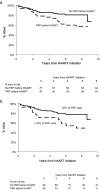A frailty-related phenotype before HAART initiation as an independent risk factor for AIDS or death after HAART among HIV-infected men
- PMID: 21719610
- PMCID: PMC3156632
- DOI: 10.1093/gerona/glr097
A frailty-related phenotype before HAART initiation as an independent risk factor for AIDS or death after HAART among HIV-infected men
Abstract
Background: In the general population, frailty, a late stage of the aging process, predicts mortality. We investigated whether manifesting a previously defined frailty-related phenotype (FRP) before initiating highly active antiretroviral therapy (HAART) affects the likelihood of developing clinical AIDS or mortality after HAART initiation.
Methods: Among 596 HIV-infected men in the Multicenter AIDS Cohort Study whose date of HAART initiation was known within ±6 months and who had an assessable FRP status within 3 years before HAART, survival analyses were performed to assess the effect of FRP manifestation on clinical AIDS or death after HAART.
Results: In men free of AIDS before HAART, AIDS or death after HAART occurred in 13/36 (36%) men who exhibited the FRP before HAART but only in 69/436 (16%) men who did not (hazard ratio = 2.6; 95% confidence interval = 1.4-4.6; p < .01). After adjusting for age, ethnicity, education, nadir CD4+ T-cell count, peak HIV viral load, and hemoglobin in the 3 years before HAART, having the FRP at >25% of visits in the 3 years before HAART significantly predicted AIDS or death (adjusted hazard ratio = 3.8; 95% confidence interval = 1.9-7.9; p < .01). Results were unchanged when the analysis was restricted to the 335 AIDS-free men who were HAART responders, to the 124 men who had AIDS at HAART initiation, or to the subsets of men for whom indices of liver and kidney function could be taken into account.
Conclusion: Having a persistent frailty-like phenotype before HAART initiation predicted a worse prognosis after HAART, independent of known risk factors.
Figures


References
-
- Fried LP. Conference on the physiologic basis of frailty. April 28, 1992, Baltimore, Maryland, U.S.A. Introduction. Aging (Milano) 1992;4:251–252. - PubMed
-
- Campbell AJ, Buchner DM. Unstable disability and the fluctuations of frailty. Age Ageing. 1997;26:315–318. - PubMed
-
- Ferrucci L, Cavazzini C, Corsi A, et al. Biomarkers of frailty in older persons. J Endocrinol Invest. 2002;25:10–15. - PubMed
-
- Bandeen-Roche K, Xue QL, Ferrucci L, et al. Phenotype of frailty: characterization in the Women's Health and Aging Studies. J Gerontol A Biol Sci Med Sci. 2006;61:62–66. - PubMed
-
- Fried LP, Tangen CM, Walston J, et al. Frailty in older adults: evidence for a phenotype. J Gerontol A Med Sci. 2001;56:M146–M156. - PubMed
Publication types
MeSH terms
Grants and funding
LinkOut - more resources
Full Text Sources
Medical
Research Materials
Miscellaneous

